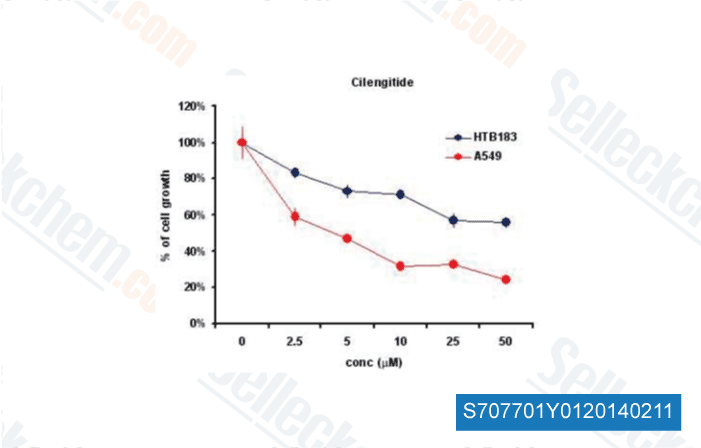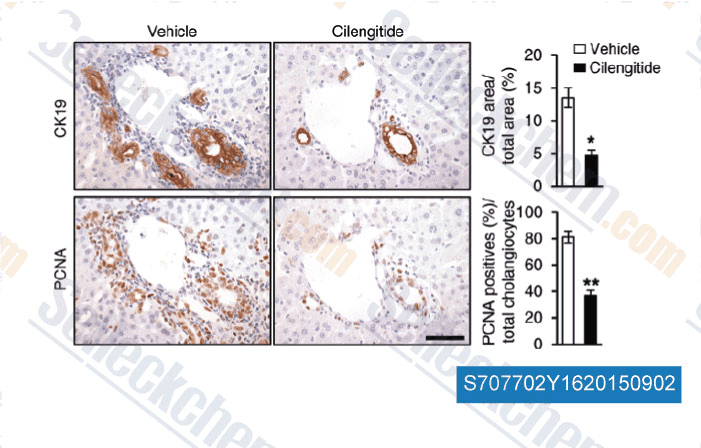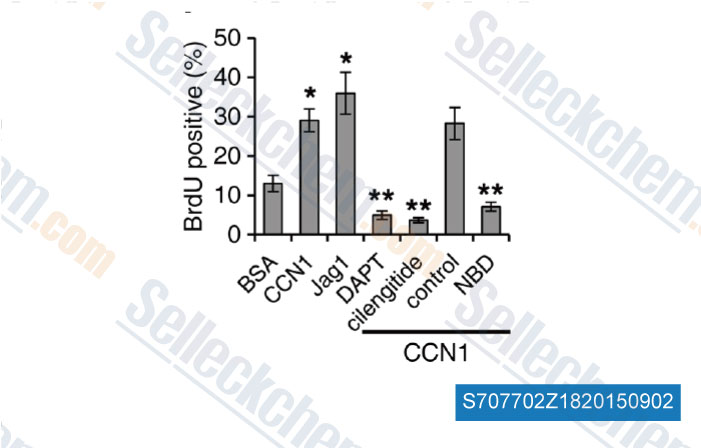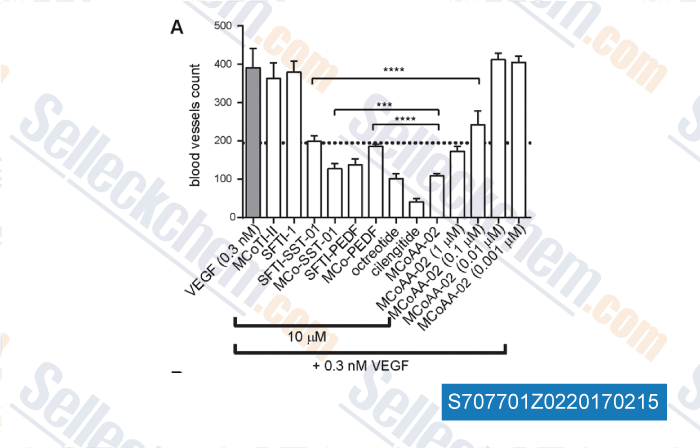|
Toll Free: (877) 796-6397 -- USA and Canada only -- |
Fax: +1-832-582-8590 Orders: +1-832-582-8158 |
Tech Support: +1-832-582-8158 Ext:3 Please provide your Order Number in the email. |
Technical Data
| Formula | C29H41F3N8O9 |
|||
| Molecular Weight | 702.68 | CAS No. | 199807-35-7 | |
| Solubility (25°C)* | In vitro | DMSO | 100 mg/mL (142.31 mM) | |
| Water | 8 mg/mL (11.38 mM) | |||
| Ethanol | Insoluble | |||
|
* <1 mg/ml means slightly soluble or insoluble. * Please note that Selleck tests the solubility of all compounds in-house, and the actual solubility may differ slightly from published values. This is normal and is due to slight batch-to-batch variations. * Room temperature shipping (Stability testing shows this product can be shipped without any cooling measures.) |
||||
Preparing Stock Solutions
Biological Activity
| Description | Cilengitide (EMD 121974, NSC 707544) is a potent integrin inhibitor for αvβ3 receptor and αvβ5 receptor with IC50 of 4.1 nM and 79 nM in cell-free assays, respectively; ~10-fold selectivity against gpIIbIIIa. Phase 2. | ||||
|---|---|---|---|---|---|
| Targets |
|
||||
| In vitro | Cilengitide is a cyclized pentapeptide peptidomimetic designed to compete for the arginine-glycine-aspartic acid (RGD) peptide sequence that regulates integrin-ligand binding. Cilengitide selectively and potently blocks the ligation of theαvβ3 andαvβ5 integrins to provisional matrix proteins such as vitronectin, fibronectin, fibrinogen, von Willebrand factor, osteopontin, and others. [1] Cilegitide inhibits angiogenesis in vitro. 10 μM Cilengitide completely inhibits attachment of BAE, BME and HUVE cells on vitronectin and fibronectin. Cilengitide inhibits in vitro angiogenesis of BAE cells on three-dimensional collagen and fibrin gels pretreated with FGF-2(or VEGF-A) with IC50 of 15 μM and 8 μM, 4 μM and 3 μM, respectively. [2] Cilengitide blocks proliferation and induces apoptosis of endothelial cells as well as differentiation of human endothelial precursor cells (EPCs). 50 μg/mL Cilengitide completely inhibits the proliferation of human microvascular endothelial cell line HMEC-1 and leads to apoptosis in ~30% cells. [3] 1.0 μM Cilengitide treating for 9 days inhibits the proliferation of EPCs by nearly 40%. 1 μM Cilengitide inhibits the differentiation of EPCs by more than 80% at 14 days. [4] Cilengitide inhibits adhesion and induces apoptosis of tumor cells. 25 μg/mL Cilengitide causes detachment of DAOY cells (medulloblastoma) and U87MG cells (glioblastoma) from vitronectin and tenascin by more than 60%. 25 μg/mL Cilengitide induces a nearly 50% apoptosis rate of these cells. [5] | ||||
| In vivo | Cilengitide is activity against tumor growth and angiogenesis as single-agent. 100 μg Cilengitide induces a significant decrease in the number of CD 31+ vessels seen in tumors (2/high-power field) compared with control tumors (56/high-power field). 100 μg Cilengitide increases cellular apoptosis in the brain tumors of animals (2.2% apoptotic cells/high-power field) compared with those receiving the inactive peptide (1.7% cells/high-power field). Cilengitide treatment results in prolonged survival of the mice bearing melanoma xenografts M21 compared with control treatment group. (36.5 vs 17.3 days). [5] Cilengitide can augment the therapeutic benefit associated with cytotoxic agents including chemotherapy and radiation therapy in tumor models. Cilengitide (250 mg/dose) alone does not alter tumor growth of breast cancer xenografts when compared with untreated mice, but combined modality RIT (CMRIT) using RIT and six doses of Cilengitide (250 mg/dose) increases efficacy of treatment, with the cure rate for mice that receives only RIT increasing from 15 to 53%. CMRIT significantly increases apoptosis of tumor and endothelial cells 5 days, and decreases tumor proliferation. [6] |
Protocol (from reference)
| Kinase Assay:[2] |
|
|---|---|
| Cell Assay:[3] |
|
| Animal Study:[5] |
|
References
Customer Product Validation

-
Data independently produced by , , Dr.Milica Pesic from Institute for Biological Research

-
Data from [Data independently produced by , , J Clin Invest, 2015, 125(5): 1886-900]

-
Data from [Data independently produced by , , J Clin Invest, 2015, 125(5): 1886-900]

-
Data from [Data independently produced by , , Sci Rep, 2016, 6:35347.]
Selleck's Cilengitide trifluoroacetate has been cited by 72 publications
| Cartilage Oligomeric Matrix Protein Promotes Radiation Resistance in Non-Small Cell Lung Cancer In Vitro [ Int J Mol Sci, 2025, 26(6)2465] | PubMed: 40141111 |
| Transendothelial migration of the Lyme disease spirochete involves spirochete internalization as an intermediate step through a transcellular pathway that involves Cdc42 and Rac1 [ Microbiol Spectr, 2025, 13(2):e0222124] | PubMed: 39727396 |
| mTORC1 Mediates Biphasic Mechano-Response to Orchestrate Adhesion-Dependent Cell Growth and Anoikis Resistance [ Adv Sci (Weinh), 2023, e2307206.] | PubMed: 38041494 |
| Fibronectin promotes tumor progression through integrin αvβ3/PI3K/AKT/SOX2 signaling in non-small cell lung cancer [ Heliyon, 2023, 9(9):e20185] | PubMed: 37809806 |
| Fibronectin promotes tumor progression through integrin αvβ3/PI3K/AKT/SOX2 signaling in non-small cell lung cancer [ Heliyon, 2023, 9(9):e20185] | PubMed: 37809806 |
| Fibroblasts generate topographical cues that steer cancer cell migration [ Sci Adv, 2023, 9(33):eade2120] | PubMed: 37585527 |
| N-acetylcysteine overcomes NF1 loss-driven resistance to PI3Kα inhibition in breast cancer [ Cell Reports Medicine, 2023, 4(4)] | PubMed: None |
| Self-generated gradients steer collective migration on viscoelastic collagen networks [ Nat Mater, 2022, 10.1038/s41563-022-01259-5] | PubMed: 35637338 |
| Developmental endothelial locus-1 protects from hypertension-induced cardiovascular remodeling via immunomodulation [ J Clin Invest, 2022, e126155] | PubMed: 35133978 |
| Osteogenesis-Inducing Chemical Cues Enhance the Mechanosensitivity of Human Mesenchymal Stem Cells for Osteogenic Differentiation on a Microtopographically Patterned Surface [ Adv Sci (Weinh), 2022, e2200053] | PubMed: 35373921 |
RETURN POLICY
Selleck Chemical’s Unconditional Return Policy ensures a smooth online shopping experience for our customers. If you are in any way unsatisfied with your purchase, you may return any item(s) within 7 days of receiving it. In the event of product quality issues, either protocol related or product related problems, you may return any item(s) within 365 days from the original purchase date. Please follow the instructions below when returning products.
SHIPPING AND STORAGE
Selleck products are transported at room temperature. If you receive the product at room temperature, please rest assured, the Selleck Quality Inspection Department has conducted experiments to verify that the normal temperature placement of one month will not affect the biological activity of powder products. After collecting, please store the product according to the requirements described in the datasheet. Most Selleck products are stable under the recommended conditions.
NOT FOR HUMAN, VETERINARY DIAGNOSTIC OR THERAPEUTIC USE.
